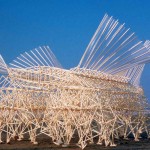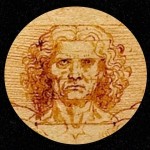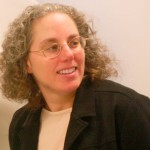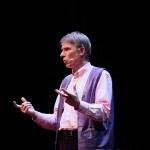by Roger Price

The Eagle Nebula in Constellation Serpens
Credit: NASA/ESA/STSci/J. Hester and P. Scowen (ASU)
The psalmist and the skeptic and the prophet and the professor look at the universe in which we find ourselves, see the same stars, feel the warmth of the same sun, hear thunder pealing from the same sky, understand the processes by which nature unfolds in spring, retreats in fall only to regenerate again the following year, and yet often draw different conclusions from the same observable data. So, for instance, in response to the emergence of humankind, a non-theist might merely record the evolutionary data or might marvel at the improbability, the mystery, and the grandeur of our existence. The traditional Jewish believer, by contrast, might offer a prayer to the Supreme Being: Blessed are You, sovereign of the universe, who has fashioned us from the dust of the Earth in Your image and breathed our soul into us.
Is there another way, a way to attempt to understand one’s place in the cosmos that is consistent with current scientific knowledge, and yet recognizes the miracle of our presence without dependence on some supernatural being? Is there an approach to the cosmos which might be attractive to many, perhaps most, American Jews who do not believe in the traditional personal God who dominates the Torah, but nevertheless accept the existence of (and may even yearn for) some extraordinary power, force or spirit which pervades all that is? And, if so, is that path kosher?
Pantheism is one possibility. The term comes from two Greek words,pan meaning all and theos meaning God. Literally, then, pantheism is the belief that all is God, that God and the universe are coextensive. This formulation also means that there is no God but the universe.
Pantheism is a word first used just over three hundred years ago to express the philosophy developed by Baruch Spinoza (1632-77 CE), a Dutch philosopher of Portuguese Jewish descent who many consider one of the foremost thinkers of the Enlightenment in seventeenth century Europe. Spinoza himself did not use the term pantheism, and there is some debate about whether his philosophy was pantheistic. But Spinoza surely did not understand God in the traditional sense of an omniscient, wise or comforting personality, or as a judge who rewards and punishes.
Rather, for Spinoza, all things in nature were in God, and God was “the active, eternal, and immutable dimension of nature.” (See Nadler,Spinoza: A Life (Cambridge University Press 1999), at 187.) Consequently, God did not perform miracles, if by that term one meant events in violation of natural laws. There could be no miracles in that sense, as there was no distinction between nature and God. Nevertheless, Spinoza was not an atheist. His God was, for him, existing and real, the infinite substance and infinitely perfect.
Of course, Spinoza, at the tender age of 23, was also ex-communicated by the leaders of his Jewish community. The precise reasons for this action are not known, as the order placing Spinoza in cherem, i.e., cursing him and expelling him, did not detail his purported offenses. But it is certainly plausible that his alleged heresies included a rejection of an anthropomorphic God, the divinity of the precepts of the Hebrew Bible and the attribution of the authorship of the text to Moses, each and all of which positions, among others, Spinoza ultimately held and discussed in his writings.
Today, pantheism comes in various forms, and pantheists debate whether and how to use God language. In general, though, pantheism is characterized by several key concepts including (1) the acceptance and utilization of science and the scientific method and (2) a strong sense, even a spiritual one, of an integrated relationship of all things in the Universe, unencumbered or unenhanced, depending on your view, by a supernatural deity.
Pantheists, moreover, take a broad view of the universe, and attempt to synthesize logic and reason with awe and wonder. Their cathedral is not a building, but the universe itself. The universe, they say “creates us, preserves us, destroys us. It is deep and old beyond our ability to reach with our senses. It is beautiful beyond our ability to describe in words. It is complex beyond our ability to fully grasp in science.”
But how exactly does a pantheist relate to the universe? According to the World Pantheist Movement, “with humility, awe, reverence, celebration and the search for deeper understanding,” ways which are and are recognized to be similar to the ways those who believe in a traditional God relate to God. Except, as a pantheist would say, “minus the grovelling (sic) worship or the expectation that there is some being out there who can answer our prayers.”
If much of this sounds familiar to Jews, apart from the reference to groveling, it should. Jews know a thing or three about oneness.
According to the Torah, as Moshe (Moses) is recapitulating the law for the emerging Israelite nation, he asks the people to pay attention to his words with these: “Sh’ma Yisrael” or “Listen, Israel” (more conventionally, “Hear, O Israel”). “יהוה Eloheinu” (“HaShem/Adonai (is) our God”), he continued, “יהוה echad” (“HaShem/Adonai (is) one”). (SeeDeut. 6:4.) This call to take heed is, perhaps, not intended to be much more than an interjection in an otherwise dense legal oration, similar to the request to listen immediately prior to the recapitulation. (SeeDeut. 5:1). Over the centuries, though, the Sh’ma has assumed prime theological importance. We may disagree about what God is, even whether God is, but if God is, then God is one.
But what does that mean? Was Moshe asserting that the Israelite God was Number 1, first among many, or was he saying something else? Certainly, the statement can and has been understood to mean that the Israelite God was a single entity, in contrast to two gods or the multiple gods of nature. In this view, the Sh’ma is an affirmation of monotheism, a pronouncement that the Israelite God was the one and only god, and, conversely, a rejection of polytheism. But, if so, theSh’ma was redundant, as at least two nearby passages which precede it explicitly state that יהוה (HaShem/Adonai) alone is God, that there is no other. (See Deut. 4:35, 39.)
Judith Plaskow, a professor of religious studies at Manhattan College, has suggested that this view of the “one God who was creator and ruler of the universe” is insufficient, for while it “defines ‘one’ in opposition to ‘many’, . . . it never really specifies what it means to say that God/Adonai/the One who is and will be is one.” (See Hoffman ed.,My People’s Prayer Book, Vol. 1 — The Sh’ma and its Blessings, (Jewish Lights 1997) at 98.)
Referencing Judaic scholar Marcia Falk’s understanding of an inclusive and not merely numerical monotheism, Plaskow argues that “Rather than being the chief deity in the pantheon, God includes the qualities and characteristics of the whole pantheon, with nothing remaining outside. God is all in all.” (Id. at 99.) Monotheism, she adds, is about “the capacity to glimpse the One in and through the changing forms of the many, to see the whole in and through its infinite images.” Here she finds “a unity that embraces and contains our diversity and that connects all things to each other.” There is precedent for this encompassing vision. Some scholars have argued that “early Hasidism had profound pantheistic tendencies and that many of its teachers saw God as the vital divine force that suffused every corner of the universe.” (See Nelson, Judaism, Physics and God(Jewish Lights 2005), at 262.) But the record is not clear.
Some modern commentators appear to share those tendencies. For instance, in a recent essay, Rabbi Bradley Shavit Artson, of American Jewish University, talks about the “reality of an evolving, emergent, dynamic creation” in which “every natural event is related to every other natural event and to all natural events.” In his creation theology, “it is not God alone who is one. All is one. We are related to each and to all, as is the Creator.” (See Artson, “Revisiting Creation, Natural Events, and Their Emergent Patterns” in The CCAR Journal, The Reform Jewish Quarterly (Winter 2012), at 76.) “We are stardust — we are all stardust,” he writes.
Similarly, in his search for new metaphors in an age of science, Reform Rabbi David Nelson, currently assistant professor of religion at Bard College, reaches to the Big Bang. He says that “The oneness of God can now be understood as indicating that everything, the totality of being itself, is, in a sense, God. ‘God is one’ may now be taken to mean the ‘God’ is a term that signifies the unity of all existence, a unity rooted in the common origin of all existence in a single point of time, space, and nascent matter.” (See Nelson, above, at 19.)
“The very term singularity,” he argues, “which has become a common place of contemporary physics, might be seen as a modern Jewish metaphor for the traditional Jewish idea of oneness.” (Id.) By singularity, Nelson is referring to the earliest moment in the history of the universe when, according to Albert Einstein’s general theory of relativity, the universe must have been incredibly small, compact and hot.
Metaphors are tricky things, however. They are, by their very nature, comparisons to and therefore dependent on an unrelated object. Consequently, if the referenced object changes, then the strength of the metaphor must change as well, and, in some cases, so too must the validity of the metaphor.
Professor Stephen Hawking has been a dominant astrophysicist for over forty years. His work in 1970 (with Roger Penrose) convinced the scientific community about there being a Big Bang singularity. Subsequently, however, Hawking recanted. Today Hawking does not dispute the description of our universe at a very young age as small, perhaps a billion-trillion-trillionth of a centimeter, and therefore unimaginably compact and hot, but argues that the predictive value of Einstein’s theory breaks down at the earliest moment of the origin of our universe, when t= 0. Indeed, Hawking’s consideration of quantum theory leads him to claim that there was “a vast landscape of possible universes.” Alluding to one of Einstein’s famous phrases, Hawking writes: “If one were religious, one could say that God really does play dice.” (The Grand Design (Bantam 2010), at 139, 144.)
The point here is not that Nelson’s metaphor fails, but that it (1) demonstrates the risk in appealing to science, especially astrophysics, that is in flux and (2) takes us only so far. Nelson himself has recognized its limits. All this does not mean that the metaphor is not useful. To the contrary, it is very useful. Nelson’s Big Bang metaphor may not take us to the original quantum event which initiated the universe as we know it, but it takes us to within a split second of that event, and to a moment before we were stardust, before there were stars. It underscores the common source of all beings, of all things. And, to the extent it does, it is of a piece with the tapestry being woven by Plaskow, Falk and Artson, with material supplied by Einstein, Spinoza and, in some ways, the biblical authors of the Sh’ma.
Moreover, the intent here is certainly not to label either Nelson, Plaskow, Falk or Artson as pantheists, but, rather, to note that some of what each contemporary Jewish scholar has written is consistent with classic pantheistic expressions on the interconnectedness of the universe and the notion of the equivalence of God and nature.
Contemporary pantheism, however, often rejects its Spinozan origins, effectively favoring pan over theism and resembling, in the end, a paganism against which Judaism has historically stood. There is, though, a related approach, panentheism, which avoids this problem.
Panentheism does not argue that God is everything, but, rather, that God is in everything. That is, it allows for a God that is, in one or some ways, more than merely the sum of the parts of the universe. This orientation also permits new language to be written by poets about the interconnected unity of energy and matter and life, about humanity’s unique role in the natural scheme of things, yet with room for that unknown force or power or energy or field or whatever it was that preceded inflation in the Big Bang model and all that followed and will follow from that first inflation and then subsequent expansion as our universe continues its journey of evolution.
In the cosmic drama that we have only recently begun to understand, Conservative Rabbi Jeremy Kalmanofsky sees “no religious response to the scope of space and time other than worshipping the Name of Existence—the sacred reality in which we participate, but that utterly transcends our place in the cosmos.” In short, accordingly to Kalmanovsky: “Finding God inhering naturalistically in all things — a theory usually called panentheism — is the only adequate religious response to science.” (See Kalmanofsky, “Cosmic Theology and Earthly Religion,” in Jewish Theology in Our Time (Jewish Lights 2011), at 25-26.) Note that Kalmanovsky is not saying that there is only one response to science. He is saying that there is only one response which is both religious, that is, which includes some concept of (a) God, and adequate, by which he seems to mean serious in its acceptance of modern science.
Pantheism, maybe, and panentheism, more certainly, seem to provide approaches which not only have authentic Jewish connections, but may also appeal to what a substantial number of American Jews claim to believe, even if they do not know the names of the philosophies they have intuitively adopted. If this is so, why haven’t the seminaries and synagogues responded?
Carl Sagan, an astronomer and writer who died too young in 1996, wrote that “(a) religion old or new, that stressed the magnificence of the universe as revealed by modern science, might be able to draw forth reserves of reverence and awe hardly tapped by the conventional faiths. Sooner or later such a religion will emerge.” (Sagan, Pale Blue Dot: A Vision of the Human Future in Space (Random House 1994), at 52.) What are we waiting for?
A version of this essay was previously published atwww.judaismandscience.com.








